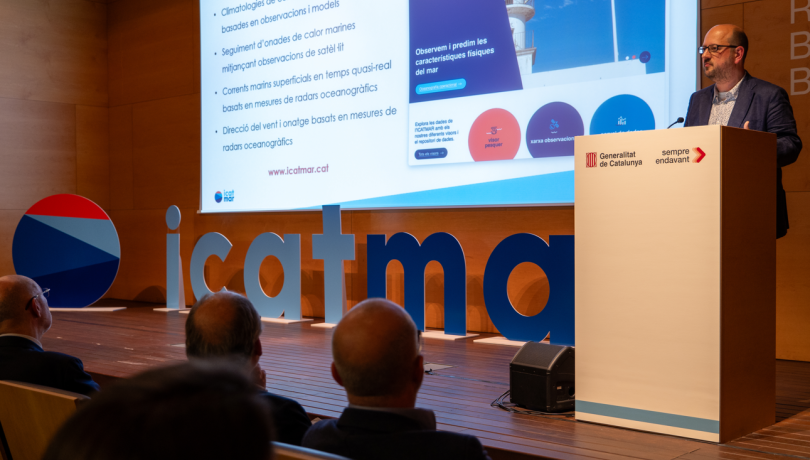In this "In Depth" we talk with Jordi Isern about the tools, services and resources that ICATMAR makes available to the maritime community.

Last March was officially presented the oceanographic institute of Catalonia(Catalan Research Institute for the Governance of the Sea - ICATMAR), a cooperative body between the Institut de Ciències del Mar (ICM-CSIC) and the Generalitat de Catalunya that will allocate in the next 7 years 18.87M€ to the deployment of tools for the collection of oceanographic data. ICATMAR was born with the aim of increasing knowledge of the biological status of species of fishing interest, quantifying the impact of recreational fishing and socio-economic monitoring of these sectors. However, since a few months ago it is also dedicated to the collection and analysis of oceanographic variables such as marine currents, temperature or water salinity. In this "A Fons" we interviewed our colleague Jordi Isern, head of the Operational Oceanography Service (SOCAT) of ICATMAR, to explain the involvement of the ICM in this organization.
What tools and resources does the ICATMAR currently have at its disposal?
The Institute is composed of ICM staff, both permanent and contracted, and staff of the Generalitat de Catalunya assigned to ICATMAR. In total we are talking about twenty people hired, in addition to another twenty people on staff. The ICATMAR also has the infrastructures that provide both institutions. A particularly unique one is the coastal observation network composed of oceanographic radars, anchored buoys and drifting buoys designed by the ICM and financed and deployed by the Generalitat de Catalunya.
What investment and deployment are planned for the coming years?
The investment of about 20 million euros made by the Generalitat is distributed in three main items: the staff of the Generalitat that makes available to ICATMAR, the deployment of the coastal observation network and the financing of the Generalitat -CSIC agreement. The ICATMAR staff, both the CSIC and the Generalitat, is practically complete. What is still in the process of deployment is the coastal observation infrastructure. This network consists of oceanographic radars to measure currents, which will be finished before Christmas this year; the anchored buoy network, which will be finished in 2026; and the set of drifting buoys, which we should receive next year. On the other hand, we are launching an oceanographic forecasting system, the first version of which will be available in the fall.
How does the marine community use these tools?
The information generated by ICATMAR is used at many different levels: local, national, state and European. For example, it is used to define EU fisheries policies. ICATMAR is also a fundamental tool for fisheries co-management committees, to which the Institute provides the necessary scientific knowledge. On the other hand, physical data are used, among others, to improve safety and act in emergencies, or to improve navigation.
What role does the marine community play in defining or designing these resources?
The scientific and technical activities of ICATMAR have been decided by us, the ICM staff, to respond to the problems of the different sectors of the maritime community. From there, a proposal has been made to the Government of Catalonia, which is the one who has sought a way to provide them with budgetary resources.
What resources does the ICM contribute to ICATMAR?
The ICM provides scientific and technological knowledge through its staff. It also provides the necessary scientific and technical infrastructure and experience in project management and coordination.
What is the new model of sea governance proposed by ICATMAR based on?
On scientific knowledge and co-management of resources. This makes ICATMAR an essential piece, since it provides the necessary oceanographic information for the governance model of Catalonia, which is based on co-management.
Are there any examples of similar bodies throughout Europe and the world?
Probably one of the most similar models to ICATMAR, which includes fisheries and physics, is the National Oceanic and Atmospheric Administration (NOAA), although on a much smaller scale. Other models that have served as a reference for us are Canada and Ireland. In terms of radar network, ours may be the densest network in Europe managed by a single institution.
What results do you expect to obtain thanks to the resources generated by ICATMAR?
Our objective is to provide oceanographic data and information. As for fisheries information, it has been provided for about four years now and the information is used to manage fisheries. As for SOCAT, which we are the newest service, we have had two products being distributed for a few months now: the ocean heat wave and temperature product and the climatological currents product. In addition, we have been distributing surface currents and waves for the past two weeks, and at the end of the year we will start distributing current, temperature and sea level forecasts, among others.
What does it mean for the ICM to be the reference center of this institution?
On the one hand, it is a recognition to the ICM, as much institutional as to the good work done, while on the other hand it allows us to advance a lot in the research we do thanks to the synergies between ICM researchers and ICATMAR staff. For example, for the first time in forty years, we have been able to create a stable oceanographic modeling group. The work of this group is to develop and operate numerical models of the ocean to make ocean forecasts. This not only allows us to have experts in modeling that can support the research we do, but also makes it possible for us to have always up-to-date ocean models that we can use in research.
Why are these types of co-governance bodies so necessary?
Because one of the bases of co-governance is oceanographic data and information, and that is what ICATMAR provides.